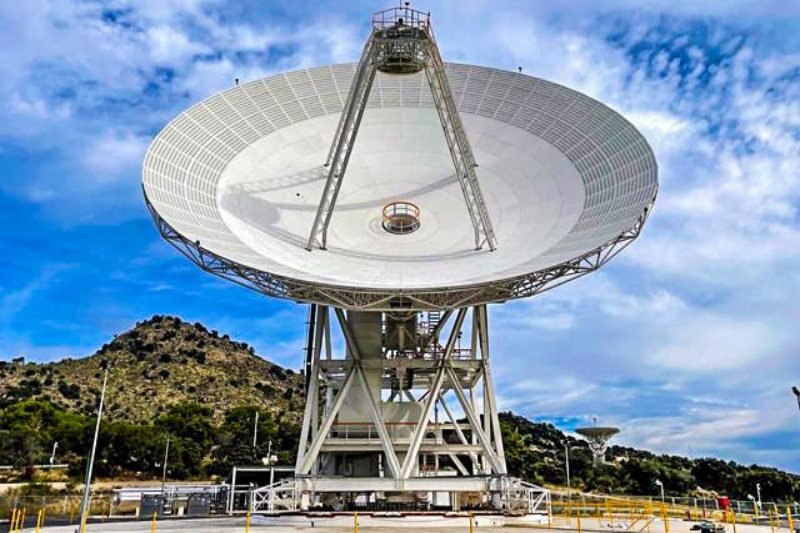NASA’s Latest ‘Hybrid Antenna’ Enhances Communications with Deep Space

NASA upgraded its antiquated communications network with a hybrid antenna, which made it possible for it to receive laser and radio frequency signals simultaneously for the first time. This enabled NASA to keep up with the growing number of deep space missions it is conducting.
NASA recently revealed that Deep Space Station 13, an experimental radio-frequency-optical hybrid antenna measuring 112 feet (34 meters) in length, had successfully tracked and decoded a signal from a gold-capped laser transceiver attached to the space agency’s asteroid mission Psyche. On October 13, 2023, the Psyche spacecraft launched the Deep Space Optical Communications (DSOC) experiment, marking the first instance of laser or optical communications being shown from a distance as far as Mars.
On January 1, 2024, the hybrid antenna downlinked a team photograph that had been uploaded to DSOC before Psyche’s launch. “Our hybrid antenna has been able to successfully and reliably lock onto and track the DSOC downlink since shortly after the tech demo launched,” Amy Smith, DSN deputy manager at Jet Propulsion Laboratory (JPL), said in a statement. “It also received Psyche’s radio frequency signal, so we have demonstrated synchronous radio and optical frequency deep space communications for the first time.”
The antenna is a component of NASA’s Deep Space Network (DSN), a global network of enormous radio antennas that the space agency has been using for the past 60 years to transmit communications with its deep space missions. The 14 dishes that make up the network are spread across three deep-space communications facilities: one near Canberra, Australia; another near Madrid, Spain; and Goldstone, California’s Mojave Desert. The California facility was the site of the most recent experiment.
As NASA launches more missions into deep space, the reliable communications network is finding it difficult to meet demand. According to a recent assessment by NASA’s Office of Inspector General, there are occasions when demand on DSN exceeds supply by up to 40%. NASA wants to help DSN meet the increasing demand for service by enabling more data transmission at a faster speed by equipping the radio antennas with the experimental hybrid capability.
The hybrid antenna downlinked data at a speed of 15.63 megabits per second in late 2023, having traveled 20 million miles (32 million kilometers) in the process. According to NASA, that is roughly 40 times faster than radio frequency transmission at that distance.
comprehension of the solar system is improved by the transmission of more precise data from deep space missions, made possible by this remarkable improvement in data transport speed. Additionally, it opens the door for more effective communication with upcoming space missions, which could completely change the way we investigate and learn about the universe. Furthermore, the speed at which data can be transmitted using laser communications is far higher, making it possible to relay large amounts of scientific data and high-resolution photos from far-off space missions quickly.
Seven incredibly accurate segmented mirrors, akin to the Webb Telescope’s hexagonal mirrors, are affixed to the interior of Deep Space Station 13’s curving surface. The laser photons are reflected by each mirror and directed towards a high-exposure camera that is fixed to the antenna’s subreflector, situated above the central region of DSN’s massive dish. Following the camera’s collection of the laser signal, the downlink ground station consists of an optical cable feeding a cryogenically chilled semiconducting nanowire single photon detector.
“We use a system of mirrors, precise sensors, and cameras to actively align and direct laser from deep space into a fiber reaching the detector,” Barzia Tehrani, communications ground systems deputy manager and delivery manager for the hybrid antenna at JPL, said in a statement.
The hybrid antenna will be tested at a distance equal to the separation between Earth and Mars at its furthest point, or 2.5 times the distance between Earth and the Sun. Upon reaching that distance in June, the Psyche spacecraft’s onboard laser transceiver will be prepared to send a signal to the antenna.
A 15-second video of Taters, an orange tabby cat, running a laser pointer up and down a couch while 19 million kilometers away from Earth was beaming by DSOC in December 2023.